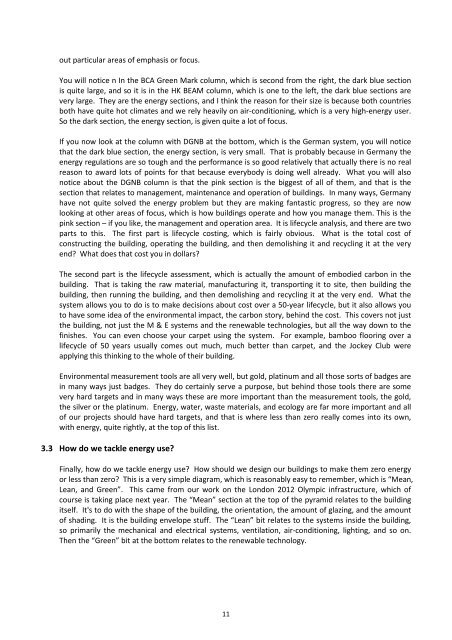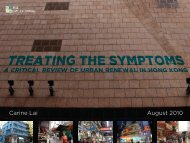Download summary report - Civic Exchange
Download summary report - Civic Exchange
Download summary report - Civic Exchange
You also want an ePaper? Increase the reach of your titles
YUMPU automatically turns print PDFs into web optimized ePapers that Google loves.
out particular areas of emphasis or focus.<br />
You will notice n In the BCA Green Mark column, which is second from the right, the dark blue section<br />
is quite large, and so it is in the HK BEAM column, which is one to the left, the dark blue sections are<br />
very large. They are the energy sections, and I think the reason for their size is because both countries<br />
both have quite hot climates and we rely heavily on air-conditioning, which is a very high-energy user.<br />
So the dark section, the energy section, is given quite a lot of focus.<br />
If you now look at the column with DGNB at the bottom, which is the German system, you will notice<br />
that the dark blue section, the energy section, is very small. That is probably because in Germany the<br />
energy regulations are so tough and the performance is so good relatively that actually there is no real<br />
reason to award lots of points for that because everybody is doing well already. What you will also<br />
notice about the DGNB column is that the pink section is the biggest of all of them, and that is the<br />
section that relates to management, maintenance and operation of buildings. In many ways, Germany<br />
have not quite solved the energy problem but they are making fantastic progress, so they are now<br />
looking at other areas of focus, which is how buildings operate and how you manage them. This is the<br />
pink section – if you like, the management and operation area. It is lifecycle analysis, and there are two<br />
parts to this. The first part is lifecycle costing, which is fairly obvious. What is the total cost of<br />
constructing the building, operating the building, and then demolishing it and recycling it at the very<br />
end? What does that cost you in dollars?<br />
The second part is the lifecycle assessment, which is actually the amount of embodied carbon in the<br />
building. That is taking the raw material, manufacturing it, transporting it to site, then building the<br />
building, then running the building, and then demolishing and recycling it at the very end. What the<br />
system allows you to do is to make decisions about cost over a 50-year lifecycle, but it also allows you<br />
to have some idea of the environmental impact, the carbon story, behind the cost. This covers not just<br />
the building, not just the M & E systems and the renewable technologies, but all the way down to the<br />
finishes. You can even choose your carpet using the system. For example, bamboo flooring over a<br />
lifecycle of 50 years usually comes out much, much better than carpet, and the Jockey Club were<br />
applying this thinking to the whole of their building.<br />
Environmental measurement tools are all very well, but gold, platinum and all those sorts of badges are<br />
in many ways just badges. They do certainly serve a purpose, but behind those tools there are some<br />
very hard targets and in many ways these are more important than the measurement tools, the gold,<br />
the silver or the platinum. Energy, water, waste materials, and ecology are far more important and all<br />
of our projects should have hard targets, and that is where less than zero really comes into its own,<br />
with energy, quite rightly, at the top of this list.<br />
3.3 How do we tackle energy use?<br />
Finally, how do we tackle energy use? How should we design our buildings to make them zero energy<br />
or less than zero? This is a very simple diagram, which is reasonably easy to remember, which is “Mean,<br />
Lean, and Green”. This came from our work on the London 2012 Olympic infrastructure, which of<br />
course is taking place next year. The “Mean” section at the top of the pyramid relates to the building<br />
itself. It's to do with the shape of the building, the orientation, the amount of glazing, and the amount<br />
of shading. It is the building envelope stuff. The “Lean” bit relates to the systems inside the building,<br />
so primarily the mechanical and electrical systems, ventilation, air-conditioning, lighting, and so on.<br />
Then the “Green” bit at the bottom relates to the renewable technology.<br />
11

















